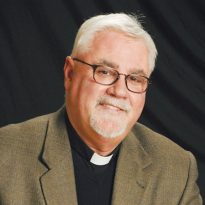SOME TIME AGO I SHARED AN ARTICLE on Facebook by Tom Raabe that was written for The Federalist titled “Why Churches Should Ditch Projector Screens and Bring Back Hymnals.”

I have been involved in church music my entire life. We had great Benedictine nuns in Sauk Rapids and good choir directors. At Cathedral High School, Phil Welter inspired me with his musical choices for the concert choir. I went on to earn a degree in choral music. So, I am quite picky about music. Let me confess to you that some of the songs we sang in the 1960s and 1970s I would never, ever do again. Those were years of adolescent growth for both me and the post-conciliar church.
What sticks in my mind and heart are hymns that were sung in childhood, adolescence and early adulthood from “Our Parish Prays and Sings, The People’s Mass Book.” Why? Because there was a solid theology behind the hymns paired with melody that sticks with me. “Now thank we all our God…who, from our mother’s arms, has blest us on our way with countless gifts of love…and still is ours today.” Wow. We sang that as the final hymn at my mother’s funeral a year ago.
There are good contemporary songs, but I do miss singing hymns out of hymnals. I am blessed to have worked with hymn-text writer Sister Delores Dufner of St. Benedict’s Monastery in St. Joseph. She gave me a deep appreciation for hymn texts that both form and send forth.
In his Harvard Lecture Series some time ago, choral conductor Robert Shaw addressed the relationship of the arts to worship. He was a preacher’s kid who had an ambivalence about “church,” sometimes referring to the “musical swill” that often fills churches or is projected over television broadcasts.

For him, the absolute minimum conditions for authentic worship were “a sense of mystery and an admission of pain.” He cited spirituals like “What wonderous love is this,” “Sometimes I feel like a motherless child” and others. Often set to wonderful folk melodies, Shaw said that these were miracles “shaped and worn by life-times and Niagaras of tears.”
He had four criteria he applied to art and to worship: 1) purity of motivation in its creation; 2) must be wellcrafted; 3) must exhibit depth; and 4) has the capacity to reveal mystery.
Don’t get me wrong, I like all types of music. Here at St. Mary’s in Alexandria, we try to do a healthy mix of styles — contemporary and traditional (including some chant). But my heart still moves toward hymns that have depth and move the heart with the sheer poetry of their verse. I tire of “I just wanna praise you” songs; they won’t stand the test of time any more than the songs of the ’60s and ’70s we sang. But — I had to go through adolescence to learn that, I guess.
So, the point of this writing is more than about liking hymnals. It is about a legacy of Western Christianity that holds a rich theology. In his article, Raabe stated: “As hymnals fade, theology also suffers. The rich repository of religious wisdom contained in hymns will be lost. The old-fashioned language of hymns may strike some as unusual, but their text teaches the Christian faith far better than most of the praise choruses that dominate contemporary services. Old hymns were carefully crafted with theology at the forefront. Traditional hymns present doctrine clearly and beautifully convey the Gospel story of saving grace.”
Raabe goes a bit overboard in his critique of “praise choruses,” but he drives home a point. “My Shepherd Will Supply My Need… O God Beyond All Praising…”. After Mom’s death, these were the songs that brought my family comfort. They were well-crafted, had depth, had the capacity to reveal and hold the mystery of dying and rising. The text by Michael Perry, verse three of “O God Beyond All Praising” is a case in point:
I don’t like to wear digital watches. Why? I can’t see what has passed and I cannot look ahead as there is only the present moment. But I wear a watch that has a traditional face. So, too, with a hymnal. When I finish a hymn, I look over the text and see how each verse progresses in the presentation of the writer’s theology. Does it develop and send us? I cannot do that with a screen. Bloop! It’s gone. (Plus…I like to read music). Here’s to hymns and hymnals!
/////////////////
FATHER STEVE BINSFELD is the pastor of St. Mary Parish in Alexandria.






















Thank you for this reflection, Fr. Steve. I, too, love the hymnal and the richness of tradition and theology contained in their pages. With a hymnal I can pray with the texts of the chosen songs before Mass, I can, as you pointed out, read the text as poetry, and I can see how the notes and music work together line by line. Hymns also offer a uniting point with other Christian traditions! Thank you for giving props to these books that have long served us well!